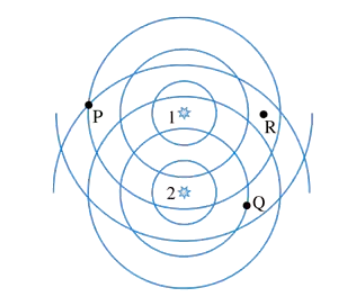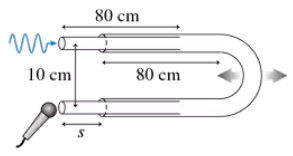 Back
BackProblem 6
FIGURE EX17.6 shows a standing wave oscillating at 100 Hz on a string. What is the wave speed?
Problem 7a
FIGURE EX17.7 shows a standing wave on a string that is oscillating at 100 Hz. How many antinodes will there be if the frequency is increased to 200 Hz?
Problem 8a
What are the three longest wavelengths for standing waves on a 60 cm long string that is fixed at both ends?
Problem 9b
Standing waves on a 1.0-m-long string that is fixed at both ends are seen at successive frequencies of 36 Hz and 48 Hz. Draw the standing-wave pattern when the string oscillates at 48 Hz.
Problem 10
The two highest-pitch strings on a violin are tuned to 440 Hz (the A string) and 659 Hz (the E string). What is the ratio of the mass of the A string to that of the E string? Violin strings are all the same length and under essentially the same tension.
Problem 13
A carbon dioxide laser is an infrared laser. A CO2 laser with a cavity length of 53.00 cm oscillates in the m=100,000 mode. What are the wavelength and frequency of the laser beam?
- The fundamental frequency of an open-open tube is 1500 Hz when the tube is filled with 0°C helium. What is its frequency when filled with 0°C air?
Problem 17
Problem 17a
The lowest note on a grand piano has a frequency of 27.5 Hz. The entire string is 2.00 m long and has a mass of 400 g. The vibrating section of the string is 1.90 m long. What tension is needed to tune this string properly?
Problem 19
A bass clarinet can be modeled as a 120-cm-long open-closed tube. A bass clarinet player starts playing in a 20° C room, but soon the air inside the clarinet warms to where the speed of sound is 352 m/s . Does the fundamental frequency increase or decrease? By how much?
Problem 21
A 170-cm-long open-closed tube has a standing sound wave at 250 Hz on a day when the speed of sound is 340 m/s . How many pressure antinodes are there, and how far is each from the open end of the tube?
Problem 22a
Two loudspeakers emit sound waves along the x-axis. The sound has maximum intensity when the speakers are 20 cm apart. The sound intensity decreases as the distance between the speakers is increased, reaching zero at a separation of 60 cm. What is the wavelength of the sound?
Problem 23b
Two loudspeakers in a 20°C room emit 686 Hz sound waves along the x-axis. If the speakers are out of phase, what is the smallest distance between the speakers for which the interference of the sound waves is maximum constructive?
Problem 24
What is the thinnest film of MgF2 (n=1.39) on glass that produces a strong reflection for orange light with a wavelength of 600 nm?
Problem 27b
FIGURE EX17.27 shows the circular wave fronts emitted by two wave sources. Make a table with rows labeled P, Q, and R and columns labeled r1, r2, Δr, and C/D. Fill in the table for points P, Q, and R, giving the distances as multiples of λ and indicating, with a C or a D, whether the interference at that point is constructive or destructive.
Problem 31
Two out-of-phase radio antennas at x=±300 m on the x-axis are emitting 3.0 MHz radio waves. Is the point (x, y) =(300 m, 800 m) a point of maximum constructive interference, maximum destructive interference, or something in between?
Problem 33
Two strings are adjusted to vibrate at exactly 200 Hz. Then the tension in one string is increased slightly. Afterward, three beats per second are heard when the strings vibrate at the same time. What is the new frequency of the string that was tightened?
Problem 34
A flute player hears four beats per second when she compares her note to a 523 Hz tuning fork (the note C). She can match the frequency of the tuning fork by pulling out the 'tuning joint' to lengthen her flute slightly. What was her initial frequency?
Problem 37
A 2.0-m-long string vibrates at its second-harmonic frequency with a maximum amplitude of 2.0 cm. One end of the string is at x = 0 cm. Find the oscillation amplitude at x = 10, 20, 30, 40, and 50 cm.
Problem 38
Tendons are, essentially, elastic cords stretched between two fixed ends. As such, they can support standing waves. A woman has a 20-cm-long Achilles tendon—connecting the heel to a muscle in the calf—with a cross-section area of 90 mm2 . The density of tendon tissue is 1100 kg/m3. For a reasonable tension of 500 N, what will be the fundamental frequency of her Achilles tendon?
Problem 40
A violinist places her finger so that the vibrating section of a 1.0 g/m string has a length of 30 cm, then she draws her bow across it. A listener nearby in a 20°C room hears a note with a wavelength of 40 cm. What is the tension in the string?
Problem 42
INT One end of a 75-cm-long, 2.5 g guitar string is attached to a spring. The other end is pulled, which stretches the spring. The guitar string's second harmonic occurs at 550 Hz when the spring has been stretched by 5.0 cm. What is the value of the spring constant?
Problem 45
In a laboratory experiment, one end of a horizontal string is tied to a support while the other end passes over a frictionless pulley and is tied to a 1.5 kg sphere. Students determine the frequencies of standing waves on the horizontal segment of the string, then they raise a beaker of water until the hanging 1.5 kg sphere is completely submerged. The frequency of the fifth harmonic with the sphere submerged exactly matches the frequency of the third harmonic before the sphere was submerged. What is the diameter of the sphere?
Problem 46
A string under tension has a fundamental frequency of 220 Hz. What is the fundamental frequency if the tension is doubled?
Problem 52
BIO Deep-sea divers often breathe a mixture of helium and oxygen to avoid getting the 'bends' from breathing high-pressure nitrogen. The helium has the side effect of making the divers' voices sound odd. Although your vocal tract can be roughly described as an open-closed tube, the way you hold your mouth and position your lips greatly affects the standing-wave frequencies of the vocal tract. This is what allows different vowels to sound different. The 'ee' sound is made by shaping your vocal tract to have standing-wave frequencies at, normally, 270 Hz and 2300 Hz. What will these frequencies be for a helium-oxygen mixture in which the speed of sound at body temperature is 750 m/s ? The speed of sound in air at body temperature is 350 m/s .
Problem 55
A 280 Hz sound wave is directed into one end of the trombone slide seen in FIGURE P17.55. A microphone is placed at the other end to record the intensity of sound waves that are transmitted through the tube. The straight sides of the slide are 80 cm in length and 10 cm apart with a semicircular bend at the end. For what slide extensions s will the microphone detect a maximum of sound intensity?
Problem 56
A 1.0-m-tall vertical tube is filled with 20°C water. A tuning fork vibrating at 580 Hz is held just over the top of the tube as the water is slowly drained from the bottom. At what water heights, measured from the bottom of the tube, will there be a standing wave in the tube above the water?
Problem 58
An old mining tunnel disappears into a hillside. You would like to know how long the tunnel is, but it's too dangerous to go inside. Recalling your recent physics class, you decide to try setting up standing-wave resonances inside the tunnel. Using your subsonic amplifier and loudspeaker, you find resonances at 4.5 Hz and 6.3 Hz, and at no frequencies between these. It's rather chilly inside the tunnel, so you estimate the sound speed to be 335 m/s . Based on your measurements, how far is it to the end of the tunnel?
Problem 61c
Two loudspeakers emit sound waves of the same frequency along the x-axis. The amplitude of each wave is a. The sound intensity is minimum when speaker 2 is 10 cm behind speaker 1. The intensity increases as speaker 2 is moved forward and first reaches maximum, with amplitude 2a, when it is 30 cm in front of speaker 1. What is The amplitude of the sound (as a multiple of a) if the speakers are placed side by side?
Problem 64
Microwaves with a frequency of 10.5 GHz are aimed downward into a flat-bottomed beaker that contains sunflower oil. A microwave detector above the beaker finds that there are strong reflections when the oil depth is 2.76 cm and 3.68 cm but at no depths in between. What is the index of refraction of sunflower oil at microwave frequencies?
Problem 65
Engineers are testing a new thin-film coating whose index of refraction is less than that of glass. They deposit a 560-nm-thick layer on glass, then shine lasers on it. A red laser with a wavelength of 640 nm has no reflection at all, but a violet laser with a wavelength of 400 nm has a maximum reflection. How the coating behaves at other wavelengths is unknown. What is the coating’s index of refraction?




